The New York City Parks Dept. opposed creation of a West Side eruv in the late 1980s but “the mayor’s office [Koch] came down hard” on the dept. and the eruv went up, said Rabbi Saul Berman in a 2013 discussion that was videotaped.
The 20-minute session, involving Yeshiva University president Richard Joel, eight rabbis, and several leaders of the Jewish community, was part of a six-month examination of eruvim sponsored by Yale and Yeshiva Universities that ran from the fall of 2012 to the spring of 2013.
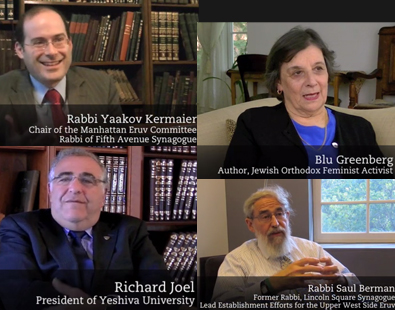 Joel said that an eruv to him was “Never, boy, now we can carry. It was now we’re a neighborhood. We’re a neighborhood that can function as a neighborhood. The concept of an eruv is such a beautiful one because what is says is that we can use the law to provoke a sense of extended family and a sense of community.”
Joel said that an eruv to him was “Never, boy, now we can carry. It was now we’re a neighborhood. We’re a neighborhood that can function as a neighborhood. The concept of an eruv is such a beautiful one because what is says is that we can use the law to provoke a sense of extended family and a sense of community.”
Faculty and students of Yeshiva in March voted "no confidence" in the administration of Joel.
Among participants was Robert Sugarman, partner of Weil, Gotshal & Manges, lead attorney for the East End Eruv Assn. which has been suing Westhampton Beach, Southampton and Quogue since 2011 in an effort to establish eruvim in those towns.
Sugarman won more than $300,000 for the Tenafly, N.J., Eruv Assn. when it scored a court victory over that city in 2002. SH, WHB, Quogue and Jewish People Opposed to the Eruv have paid more than $1 million to outside law firms thus far in an effort to block eruvim in their towns.
Sugarman said “some members of my family don’t hold by this or that eruv and one doesn’t hold by eruv at all.” The comment is at 7:56 of the vimeo tape of the discussion.
NYC Eruv was “Difficult," Costly
Rabbi Berman, associate professor, Yeshiva University, who led efforts to create an upper West Side eruv, notes the difficulty of establishing an eruv in a city such as New York, saying it took “an enormous amount of time” to come up with a solution. Quotes below were taken from a transcription of the video by a service.
“The Parks Department was very opposed to every step of this because it involved canisters and wires being installed in lampposts at the edges and sometimes within the parks,” he said. “But the Mayor's Office [Mayor Edward Koch] came down on them very hard and insisted that they cooperate with us. The process of installation began in late 1992 and it took them until 1994…”
Berman noted that support was being given to Koch for his re-election campaign. Koch was mayor from 1977-89.
“We said we need the mayor to support authorization for the construction project,” said Berman. Obtaining a “proclamation from an official was described as “the first step in creating an eruv.”
Berman described the technical problems involved in creating the eruv.
“The vast majority of the space of the Upper Westside was actually enclosed by walls or buildings. All of those walls were intersected by openings of transverses through the park or streets running north-south. To deal with those, the traditional response has been just as in a walled city, which may have multiple gates that even if the gates are open, so long as the gates are capable of being closed, that it is considered to be enclosed. It occurred to me that it should be possible to create some form of door that would be possible… through which it would be possible to close every one of those intersections.
“I was working with engineers to try to figure out a way to create [inaudible phrase] that could possibly be acceptable in the City of New York; it took an enormous amount of time to get the development of canisters which could… without great fanfare, be attached to lampposts which would contain the doors that could in fact be stretched across the intersection and then rolled back up into the canisters…”
Eruv Is Social Force, Helps Women
Rabbi Yaakov Kermaier of the Fifth Avenue Synagogue and chair of the Manhattan Eruv Committee, said “The eruv not only provides a means for somebody to carry his key or just to carry books. It really is a vital facilitator of social communal connections.” Maintaining an eruv is something that "we take as a very, very serious and sacred responsibility," he said. The boundary of the Manhattan eruv is checked every Thursday, he added.
The creation of the Manhattan eruv, said Blu Greenberg, author specializing modern Judaism and women’s issues, “essentially emancipated the women.” It showed “sensitivity to women and young children,” she said.
Rabbi Kermaier said, “A real interesting group of women that met during the week found themselves entirely isolated on a social level from other young families. So they decided what we are going to do is we’ll get together on a Monday night or a Tuesday or a Wednesday night so at least we have some sort of communal, social interaction which would normally be in the context of a Synagogue on a Shabat morning but which they don’t have access to because there was no eruv.”
Rabbi Israel Rivkin, chairman of the Edison-Highland Park eruv, said, “The rumbling started. Why don’t we have an eruv you know? We’re all prisoners.”
Stephen Savitsky, former Orthodox Union presidentr (2004-11) who helped to establish the Kew Gardens eruv, recalled the joy that accompanied it. “You know, the first Shabbos that it was up, Steve Roland [inaudible] and I, with our wives, we walked…the whole community from park to park, from street to street and we were beaming. It was unbelievable. It was amazing! People were out for the first time! People were looking at us like they were freed. You needed permission from the city for every step of this.”
Non-Religious Jews Opposed Eruv
Steve Orlow, ex-NYC Council member who helped establish the Kew Gardens eruv, said “The major objection came not from gentiles but from non-religious Jews who were sometimes terrified—petrified or upset—that the ambience of the community would change, that they would feel uncomfortable, for example, if on the Sabbath, they would drive, or they would walk around…in clothing that might be inappropriate…” He noted that besides the City of New York and its Park Dept., also involved were the telephone company, Con Edison, the State Highway Dept. and the City Highway Dept.
Others in the discussion were: Rabbi David Fuld, who helped to establish the Kew Gardens eruv; Els Bendheim, who helped to establish the Manhattan eruv in 1962; Rabbi Haskel Lookstein, principal of the Ramaz School, who helped to set up and administer the Manhattan eruv, and Rabbi Norman Lamm, Chancellor Emeritus of Yeshiva, who helped in the Manhattan eruv.


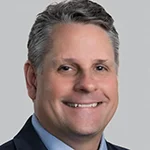 Husch Blackwell Strategies has added FleishmanHillard alum Michael Slatin as a principal in its public affairs group.
Husch Blackwell Strategies has added FleishmanHillard alum Michael Slatin as a principal in its public affairs group.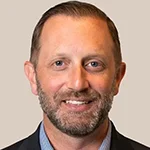 Rory Cooper, a veteran Republican operative and policy specialist, has joined Teneo’s Washington office as senior managing director in its strategy & communications practice.
Rory Cooper, a veteran Republican operative and policy specialist, has joined Teneo’s Washington office as senior managing director in its strategy & communications practice.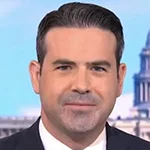 Brian Fallon, who served as national press secretary for Hillary Clinton’s 2016 presidential run, is signing on next month as Vice President’s Kamala Harris’ campaign communications director.
Brian Fallon, who served as national press secretary for Hillary Clinton’s 2016 presidential run, is signing on next month as Vice President’s Kamala Harris’ campaign communications director. TikTok is nothing more than a Chinese propaganda tool that poses “a grave threat to America’s national security and, in particular, impressionable children and young adults,” say two Congressmen who want the platform registered as a foreign agent.
TikTok is nothing more than a Chinese propaganda tool that poses “a grave threat to America’s national security and, in particular, impressionable children and young adults,” say two Congressmen who want the platform registered as a foreign agent.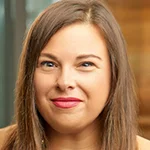 Public Strategies Washington has added Abbie Sorrendino, a former aide to now Senate Majority Leader Chuck Schumer.
Public Strategies Washington has added Abbie Sorrendino, a former aide to now Senate Majority Leader Chuck Schumer.


 Have a comment? Send it to
Have a comment? Send it to 
No comments have been submitted for this story yet.